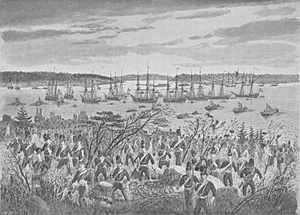Battle of Lemo facts for kids
Quick facts for kids Battle of Lemo |
|||||||
|---|---|---|---|---|---|---|---|
| Part of the Finnish War | |||||||
 Swedish troops landing at Lemo, by Jacob Hägg |
|||||||
|
|||||||
| Belligerents | |||||||
| Commanders and leaders | |||||||
| Strength | |||||||
| 2,400–2,600 6 guns |
3,600 8 guns |
||||||
| Casualties and losses | |||||||
| 217 or 218 killed, wounded or captured | 218–298 killed, wounded or captured | ||||||
The Battle of Lemo was a fight during the Finnish War between Sweden and Russia. It happened on June 19–20, 1808.
Around 2,500 Swedish soldiers landed at Lemo in Kaarina, Southwest Finland. They were helped by the Swedish Navy. The Swedes wanted to free Turku (also called Åbo) from Russian control. Major General Eberhard von Vegesack led the Swedish landing forces. The Russian army had about 3,600 men in the area. They were led by Lieutenant General Karl Gustav von Baggovut.
Contents
What Happened at Lemo?
Major General von Vegesack quickly started to build defenses where they landed. Their main defense line was set up facing an open field. They placed their cannons in front of the Ala-Lemo Manor house. Swedish gunboats were positioned to protect the strait and watch the battlefield. The Russian troops were spread out in small groups along the main road from Turku to Vyborg.
First Day of Fighting (June 19)
The Swedes had a good start. They managed to move several kilometers forward. They could even see Turku in the distance. However, Russian soldiers from the Libau Infantry Regiment, with one cannon, launched a counterattack. They pushed the Swedish troops back to their main defense line.
General von Vegesack immediately attacked the center of the Russian forces. The Russian commander, Baggovut, received more soldiers. He attacked with his forces split into three groups. Two companies attacked on the right, two on the left, and two companies with a cannon in the middle. Lieutenant von Vegesack (the general's son) found the Russian left side open. He attacked right away. The Russians had to move back a few kilometers to defend themselves. The Swedish troops followed them.
Second Day of Fighting (June 20)
Major General Nikolay Borozdin gathered more soldiers for Russia. He got 300 men from the Brest Infantry Regiment, two more cannons, and a group of soldiers from the Finland Dragoon Regiment. Early in the morning, the Libau Infantry Regiment attacked again. They made the Swedish troops retreat back to their main defense line.
General von Vegesack ordered all available men from nearby islands to come to the Lemo battlefield. This helped to make the Swedish defense line stronger. Baggovut also received more help. He got the Pernov (Pärnu) Musketeer Regiment.
The Russians then launched a full attack using bayonets. The Pernov Regiment attacked on the right, the Libau Regiment in the center, and the Brest Regiment on the left. The Russian cannons set the Ala-Lemo Manor house on fire. The Swedes were forced to pull back. Eventually, they had to leave the land and get onto their ships. Fortifications on the shore and later the gunboats protected the Swedes as they fled. Russian cannons moved to the shore and fired at the Swedish ships. General von Vegesack took both his land and sea forces back to the Åland Islands.
After the battle, the Russians had extra soldiers at Yli-Lemo. These included two companies from the Nevski Regiment and a small group from the Finland Dragoon Regiment.
Remembering the Battle
In the summer of 2008, a special monument was put up near the Yli-Lemo Manor house. It is called Kuoleva Soturi, which means "Dying soldier". The sculptor Heidi Limnell created it. This monument remembers all the soldiers who died in the Battle of Lemo. It was inspired by a poem called Den döende krigaren from The Tales of Ensign Stål.
See Also


